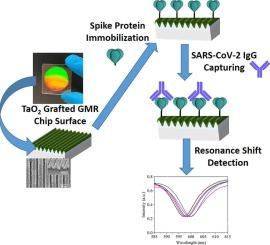Enhanced detection of SARS-CoV-2 antibodies using guided-mode resonance biosensors: A label-free approach
IF 4.9
2区 化学
Q1 CHEMISTRY, ANALYTICAL
引用次数: 0
Abstract
This study presents an alternative approach for the label-free and highly sensitive detection of SARS-CoV-2 antibodies using Guided-Mode Resonance (GMR) biosensing technology. The GMR biosensor was optimized using two distinct protein immobilization techniques—glutaraldehyde cross-linking and EDC/NHS covalent binding —applied to a Tantalum dioxide (TaO2) surface, with the aim of maximizing the sensor's detection capabilities. With an attempt to study surface binding capability between each immobilization technique, the TaO2 film is prepared by optimizing surface morphology via deposition at different operation pressures, giving film formation with different surface morphology, roughness, and area. At lower pressures, the EDC/NHS immobilization method outperformed glutaraldehyde, achieving a limit of detection (LOD) of 272.4 pg mL−1 at 5 mTorr TaO2 deposition pressure. However, at 20 mTorr, glutaraldehyde exhibited superior sensitivity, with an LOD of 72.3 pg mL−1, compared to 137.7 pg mL−1 for EDC/NHS. These results suggest that surface roughness and morphology significantly improve protein immobilization and antibody binding efficacy. This high level of sensitivity and versatility underscores the potential of the GMR biosensor for clinical applications, such as early detection of SARS-CoV-2 antibodies, post-vaccine monitoring, and immune response evaluation in low-titer samples. The study also highlights the importance of optimizing surface pressure and immobilization techniques to enhance biosensor sensitivity. The pressure-dependent performance suggests that higher surface area prepared under higher deposition pressure facilitates more efficient protein immobilization, leading to stronger antibody binding events and improved detection limits. Overall, the GMR-based biosensor system offers a promising platform for sensitive, label-free detection of SARS-CoV-2 antibodies, with potential applications in infectious disease diagnostics and monitoring.

导模共振生物传感器增强SARS-CoV-2抗体检测:一种无标记方法
本研究提出了一种利用导引模式共振(GMR)生物传感技术对SARS-CoV-2抗体进行无标记和高灵敏度检测的替代方法。利用两种不同的蛋白质固定技术-戊二醛交联和EDC/NHS共价结合-应用于二氧化钽(TaO2)表面,优化了GMR生物传感器,目的是最大化传感器的检测能力。为了研究各种固定技术之间的表面结合能力,在不同的操作压力下,通过沉积优化表面形貌,制备了具有不同表面形貌、粗糙度和面积的TaO2膜。在较低的压力下,EDC/NHS固定方法优于戊二醛,在5 mTorr TaO2沉积压力下达到272.4 pg mL−1的检出限(LOD)。然而,在20 mTorr下,戊二醛表现出更高的灵敏度,LOD为72.3 pg mL−1,而EDC/NHS的LOD为137.7 pg mL−1。这些结果表明,表面粗糙度和形态显著提高了蛋白固定化和抗体结合效率。这种高灵敏度和多功能性强调了GMR生物传感器在临床应用中的潜力,例如早期检测SARS-CoV-2抗体、疫苗后监测和低滴度样品的免疫反应评估。该研究还强调了优化表面压力和固定技术以提高生物传感器灵敏度的重要性。压力依赖性性能表明,在较高的沉积压力下制备的较高的表面积有助于更有效的蛋白质固定,从而导致更强的抗体结合事件和提高的检测限。总体而言,基于gmr的生物传感器系统为SARS-CoV-2抗体的灵敏、无标记检测提供了一个有前景的平台,在传染病诊断和监测方面具有潜在的应用前景。
本文章由计算机程序翻译,如有差异,请以英文原文为准。
求助全文
约1分钟内获得全文
求助全文
来源期刊

Microchemical Journal
化学-分析化学
CiteScore
8.70
自引率
8.30%
发文量
1131
审稿时长
1.9 months
期刊介绍:
The Microchemical Journal is a peer reviewed journal devoted to all aspects and phases of analytical chemistry and chemical analysis. The Microchemical Journal publishes articles which are at the forefront of modern analytical chemistry and cover innovations in the techniques to the finest possible limits. This includes fundamental aspects, instrumentation, new developments, innovative and novel methods and applications including environmental and clinical field.
Traditional classical analytical methods such as spectrophotometry and titrimetry as well as established instrumentation methods such as flame and graphite furnace atomic absorption spectrometry, gas chromatography, and modified glassy or carbon electrode electrochemical methods will be considered, provided they show significant improvements and novelty compared to the established methods.
 求助内容:
求助内容: 应助结果提醒方式:
应助结果提醒方式:


